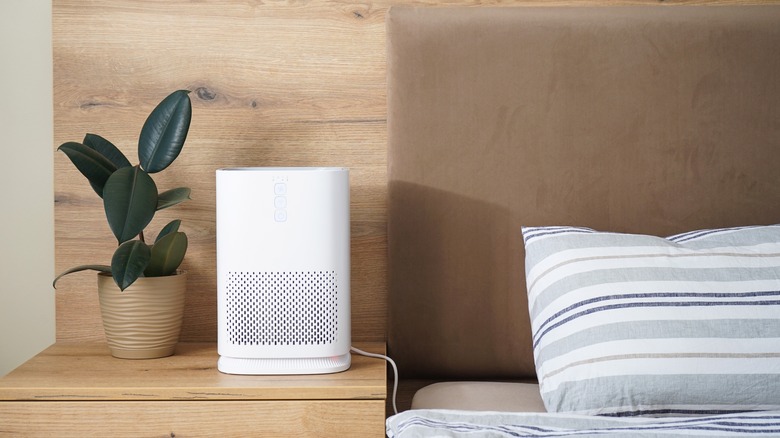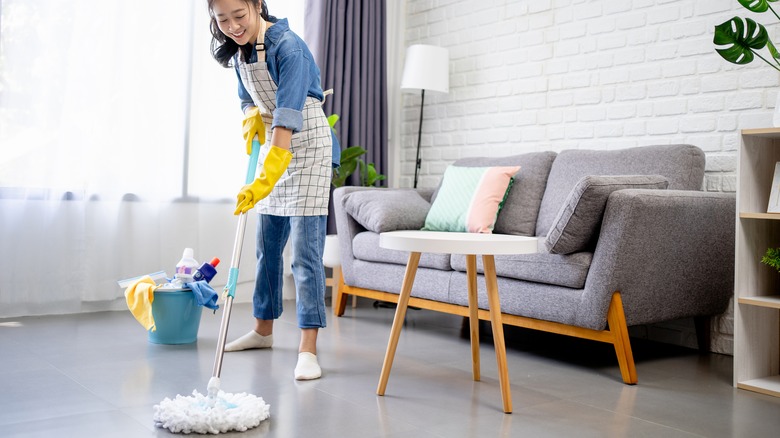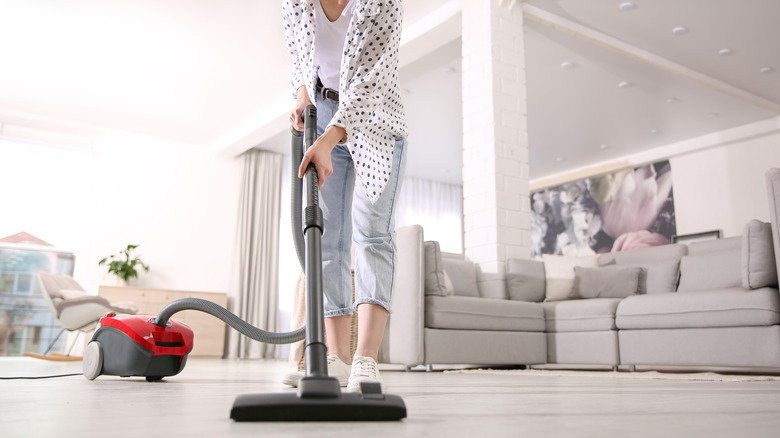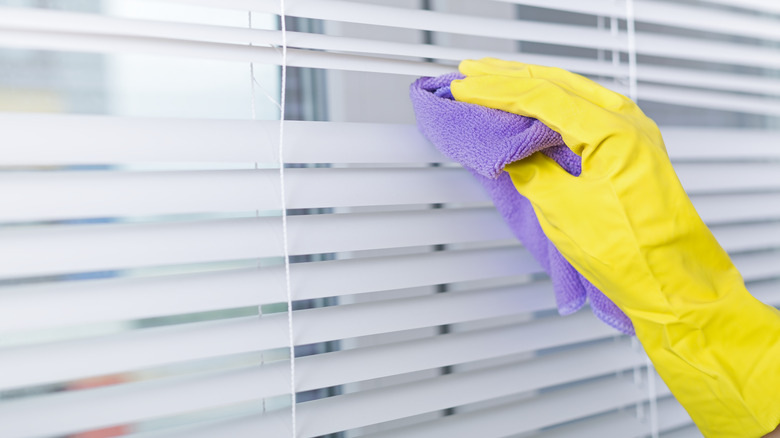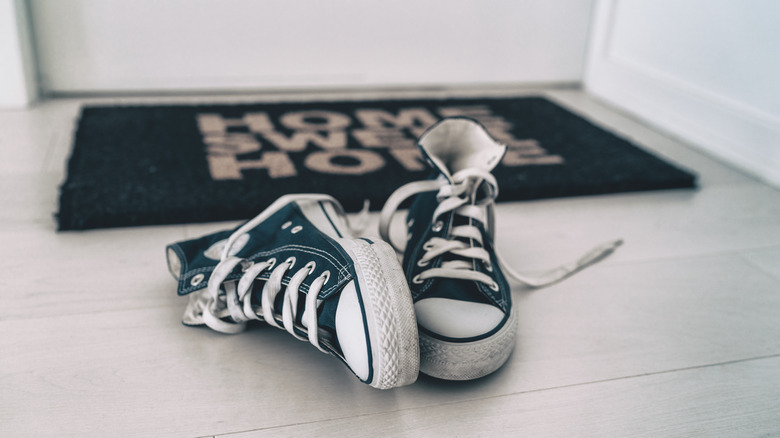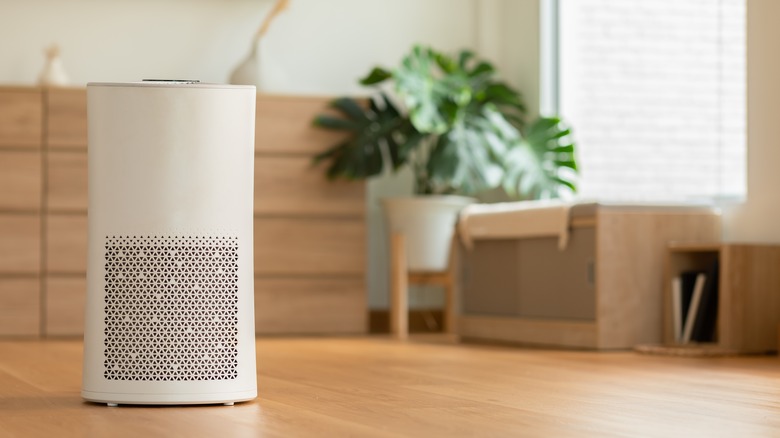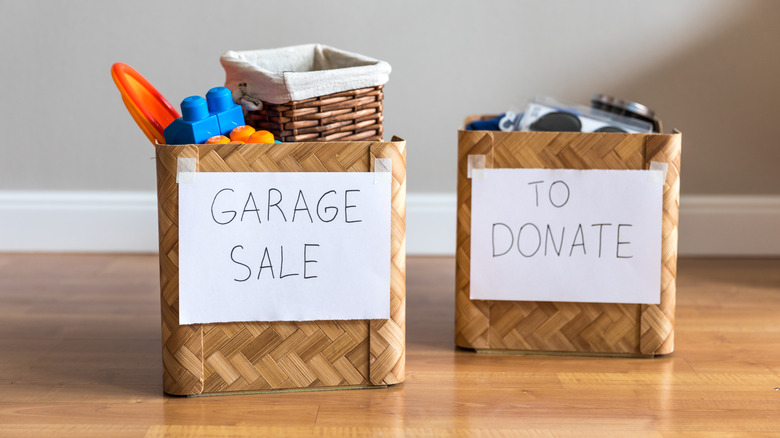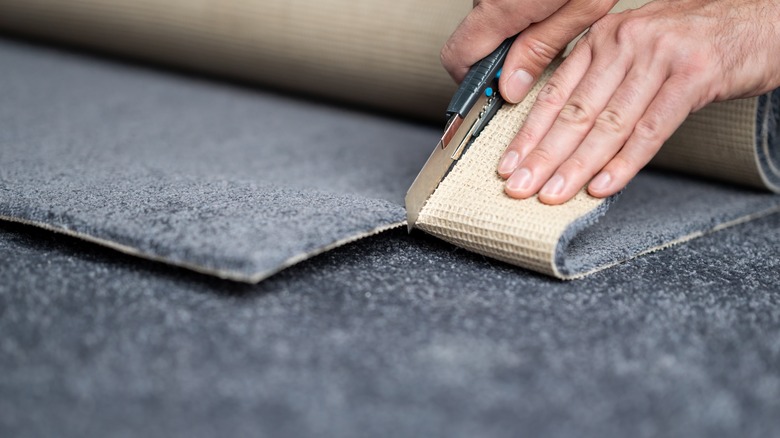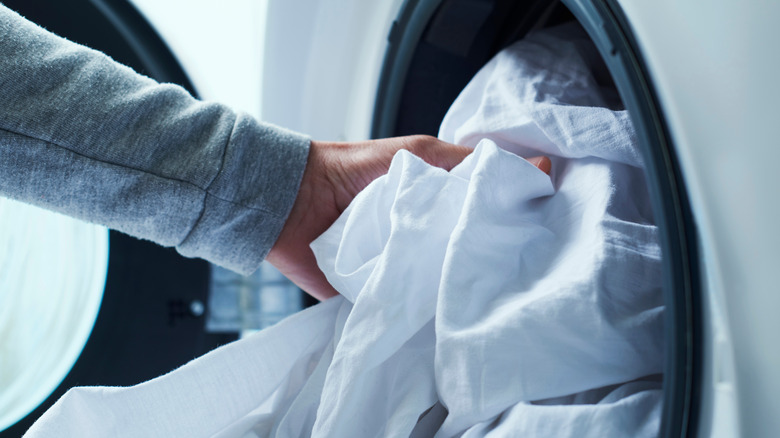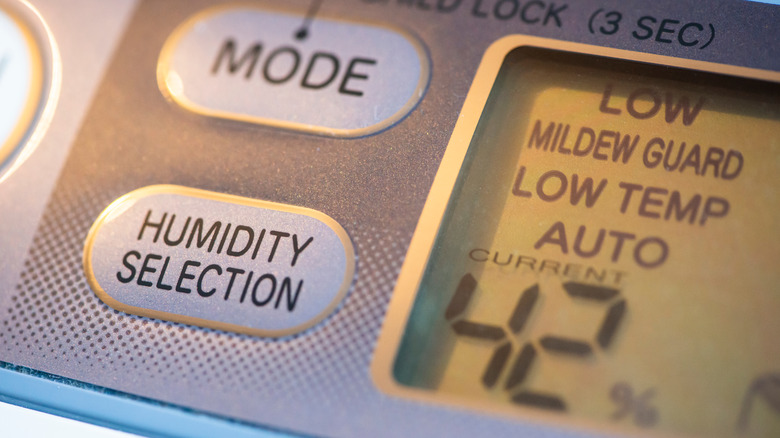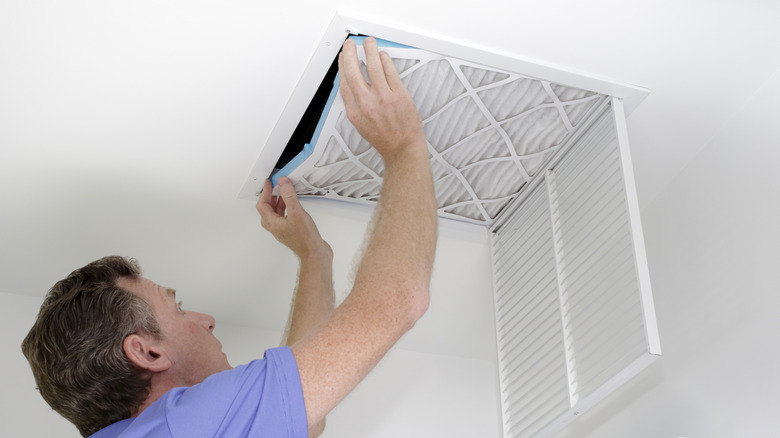How To Get Rid Of Dust In The Air
We all know the phrase "let the dust settle," which refers to waiting until things calm down after a problem. But if the problem in your home is actually dust, you shouldn't wait until it settles. Unfortunately, dust is an ongoing issue that needs to be maintained, especially if you have health problems related to it, like asthma or allergies.
What exactly is dust? Yes, it's the fine grayish powder that we see accumulating on our countertops and in the corners of our homes. But when you really break it down, dust is made of dust mites, which are microscopic nuisances similar to insects. They eat dead skin cells from humans. If you really want to be grossed out, consider the statistic from the American Lung Association: every day, a human sheds 1.5 grams of skin, which provides enough food for 1 million dust mites.
Dust is in our homes, in our furniture, in rugs, in our bedding, and in our clothing. While it can seem challenging and never-ending to get rid of it, or at least minimize it, it can be done. Read on for 11 ways to get rid of dust in the air.
Dust regularly
One of the best ways to fight dust is to clean it up regularly. So, grab your microfiber cloth, your favorite wood or surface cleaner, and your broom, and let's get started. First, inventory your house and see where most of the dust collects.
For example, in your bedroom, the nightstand is probably dusty, and so is the area behind your bed and under it. In the kitchen, look for dust on top of shelves, between cabinets and appliances, and pull out the fridge and the stove, where you'll probably find a lot of dust. Your living room and family room probably have a lot of dust, too, so check TV cabinets, bookshelves, and end tables. Check vents, ceiling fans, blinds, and draperies in every room, which are the top places where dust likely accumulates. Next, devise a plan to dust each room and do it regularly. Dusting every week or two is recommended to prevent it from building up.
Vacuum often with a vacuum that has a HEPA filter
Vacuuming is another great way to get rid of dust, but you can't use any old vacuum. You really need to make sure it has a HEPA filter. HEPA stands for "high-efficiency particulate air [filter]." These powerful filters can eliminate at least 99.97% of dust and other things in the air, including mold, pollen, and bacteria. Vacuums with a HEPA filter can be highly effective at sucking up contagions all over your home.
Still, there is a lot to think about when buying a HEPA vacuum. When looking at different brands and models, consider the vacuum's airflow, how much power it uses, durability and warranty, and performance. Also, weigh how user-friendly it is. For example, some vacuums are canisters while others are upright; some require you to empty the bin with loose dust, while others collect the dust inside sealable bags. Before buying a vacuum, check out our survey results for the most popular vacuum brands.
Wipe down your blinds to remove dust
Window coverings, including blinds, are some of the most common places for dust to collect. It makes sense too, especially if you have the windows open from time to time. All that dust and debris that gets blown in just sits on the slats of the blinds.
There are many ways to clean blinds, such as using a feather duster, a dryer sheet, or a microfiber towel. Wood blinds are best cleaned with a dry microfiber towel, while plastic or vinyl blinds can be cleaned with a damp microfiber towel. Start at the top of the blinds and work your way to the bottom. Be sure to vacuum up any dust particles that land on the floor. It's recommended to clean blinds every few weeks. However, if you live in a dusty climate or you keep the windows open a lot, you may need to wipe them down more often.
Keep dust outside
The National Center for Healthy Housing reports that almost 2/3 of the dust in the house comes from outside. While it may seem impossible to keep dust out of your home, you can do a few simple things to minimize how much of it gets inside.
One way to do that is to take your shoes off at the door. That helps keep dust and debris outside where it belongs. If you don't have a mud room and don't want to remove them outside, use a doormat to scrape your shoes before walking into a home. Encourage your guests to take their shoes off inside, too. If you still want to wear shoes in the house, make sure your house shoes or slippers are only worn indoors. Another idea is to close doors and windows at home as much as possible, which can help also minimize the amount of dust that comes indoors.
Filter the air with air purifiers
An air purifier can literally clear the air in your home. "The use of an air purifier that can capture the small particles of house dust mites can be helpful to reduce exposure," pediatric allergy nurse consultant Aneta Ivanova told Live Science. Consumer Reports did lab tests on air purifiers and found HEPA filter purifiers can help reduce half of the particles in the air at a house, including dust.
Air filters work on a room-by-room basis, so you must buy a purifier for every room you want to clean the air. When looking for the perfect model, consider where you want to put it. It makes sense to put it in a high-traffic area, like a family room, where you have a lot of doors and windows and dust coming inside. Be mindful that you will have to change out air filters a few times a year. The filters are important because they help the purifier run more efficiently.
Groom your pets often
If you have a dog or a cat, you definitely need to dust often. That's because warm-blooded animals shed pet dander, which is like dandruff, and many of them shed pet hair as well. You might not see the dander, and the fur might seem harmless, but it can be a major source of allergies for adults and children.
One of the best ways to manage pet dander and shedding is to groom your dog or cat regularly. Every six weeks, you can take your pet to a professional groomer, or you can bathe your pet at home. You can also do some daily maintenance, such as brushing your dog or cat's fur. It's a good idea to brush outside to minimize how much hair and dander gets loose in the house. After brushing, clean up the area where you groomed your pet. Use a microfiber towel or mop to pick up the dust and particles. Air purifiers with HEPA filters can also help remove pet dander, hair, and dust from your home.
Be minimalist and minimize clutter
There's a reason why clutter is often referred to as dust collectors. From a lot of knickknacks and books on your shelves, to extra shoes piled up in your bedroom, or a lot of electronics like tablets, chargers, and remote controls on your table, clutter can take over your home. And all that clutter attracts dust.
If you can minimize clutter, you can minimize dust since there's less stuff for it to cling to. That makes it easier to clean your home. Get started by first tackling some obvious clutter culprits, like pantries, linen closets, junk drawers, and mug cabinets. Cut what you don't want, what is broken, and what is no longer useful. Then move onto harder decluttering zones, like wardrobe closets, open shelving stuffed with bric-a-brac, and kids' bedrooms. If you need more guidance, remember what Sacha Dunn of eco-friendly soap company, Common Good, told Southern Living: "Declutter, then dust, then clean."
Get rid of any items you don't need or want, and make a plan to keep the remaining things dust-free. For example, store like-items such as craft supplies or hair products in a bin with a lid. While you'll have to dust the bin, at least you won't have to wipe all the items inside it.
Get rid of wall to wall carpeting
If you want to get rid of dust in your home, carpeting is one of the best things to get rid of. Wall-to-wall carpeting traps dust, dirt, and other debris that you might not see. While you might spot some dust in the corner, there's a lot more that's invisible to the naked eye.
But if you do choose to carpet, find something with a short pile so it won't trap as much dust. You can also try hypoallergenic rugs, like jute and sisal, which can help reduce allergens in your home. You can also use throw rugs, which can easily be put into the washing machine to be thoroughly cleaned. Ideally, you will have easy-to-clean floors, such as hardwood or tile, which can be dry or wet mopped to pick up dust. For best results, dust your floors daily, especially if you have pets and/or allergies.
Wash your sheets in hot water frequently
Dust — that you can and can't see — can really build up on fabrics. "If you're not already washing your sheets weekly, now's the time to start. Not only are you sleeping in your own dirt, sweat, body oils, and skin cells, but dust mites can also reside on your bed," Jill Zwarensteyn, a certified sleep science coach at Sleep Advisor, told Express. "Dust mites are invisible to the naked eye, but if you do see some creepy crawlers in your bed, those are likely bed bugs, a whole other issue."
To combat this, use dust-proof covers for your bedding, including pillows, mattresses, and box springs, since the covers don't allow dust mites to permeate the surface. It's wise to wash your bedding every week as well. Make sure the temperature is at least 130°, which is hot enough to kill dust mites.
Check your home's humidity levels because dust thrives in high moisture
You might not realize it, but humidity in your home can significantly impact dust. "House dust mites like the warmth of our homes and thrive in humid environments," pediatric allergy nurse consultant Aneta Ivanova told Live Science. "They are often found in bedrooms, in bedding and mattresses, and in living areas where there are carpets, curtains, and soft furnishings ... They exist despite regular cleaning."
Dust mites love to eat dead human skin, and in high humidity, those dead skin cells are hydrated, making them a very satisfying meal. It's important to keep humidity levels below 50% to manage dust mites. When humidity is below 30%, it's even better for allergy sufferers. Luckily, modern technology can help you track and manage these levels. Humidity gauges can tell you how humid it is in the room. If you have too much, a dehumidifier can suck the excess moisture from the air.
Change out HVAC air filters
In addition to buying a vacuum with a HEPA filter and installing air purifiers, it's also smart to regularly change your HVAC air filters. The air filters, which fit between the HVAC blower and air duct, clean the air coming through your home's heating and cooling system. They are relatively inexpensive and can be bought online or at home improvement or big box stores. It's a good idea to replace filters every few months to help keep the air as fresh as possible.
Consumer Reports advises checking the filtration level when you buy an HVAC filter. The standard in the industry is known as MERV, which stands for minimum efficiency reporting value. MERV ratings run from 1 to 16, with 16 being the best. Filters with a MERV rating of 8 or higher do a pretty good job of removing dust particles in the air, as well as pollen and mold spores.
